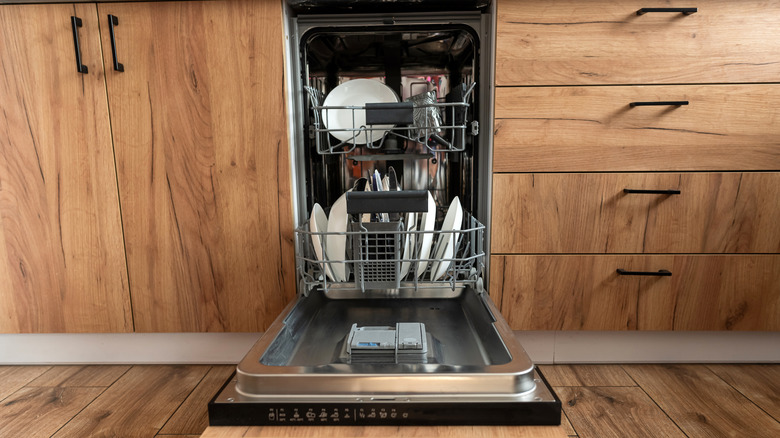Why Your Dishwasher Door Isn't Staying Open And How To Fix The Issue
We may receive a commission on purchases made from links.
Have you ever heard of a friction sleeve? Probably not, but if you have a dishwasher door that won't stay open, a faulty friction sleeve is likely the culprit. Yes, your dishwasher has a rubber friction sleeve (or friction pad) on each side of the dishwasher's door. These small, somewhat flat, flexible plastic gaskets — which look like very small, thick rubber bands — prevent the door from closing when it's open by providing resistance. When one fails — which happens with time and age, even among the highest-rated dishwashers — they do not provide the resistance needed to keep the springs from pulling the door closed. As such, you can end up with a door that won't stay open.
The good news is these parts are inexpensive at under $10, and you can do the repair on your own without too much trouble. It will be considerably easier, however, if you uninstall the dishwasher, as the friction sleeves are tucked back on each side of the door, between the machine and the cabinet or wall.
Turn off and disconnect the power and water before getting started. Find the mounting brackets that keep your dishwasher attached to the countertop, and remove the screws so you can easily pull out the machine for better access. You will also want to remove the toe-kick and possibly lower the dishwasher using a wrench and the leveling legs before pulling the machine out. Go slowly! There are hoses and wires back there.
Replace the friction sleeve on your dishwasher
Once you've pulled out the dishwasher a few inches — just far enough so you can easily see the area you want to work on — look for the door link. You'll see a spring connected to a hinge by a plastic link. While you're at it, inspect both friction pads. In some cases, only one may be missing or broken, but you may want to save yourself some future trouble and replace them both while you've got the machine pulled out.
Once you have identified the link, remove it from the hinge, being careful not to break anything. If the old friction sleeve is still there, remove it. Now, simply slide the new friction pad over the hinge. There's no secret to this other than putting a bit of elbow grease into the effort. You may need to pull the hinge slightly away from the dishwasher, and there will likely be a tab on the hinge that the pad needs to slide over to get into the right position. That will help you know when it's in the right spot.
The parts and process may look slightly different based on your particular dishwasher. Once the pads are installed and the link is reattached, it's time to put things back the way they were. Learn more about the common mistakes to avoid when installing a dishwasher to be sure you put everything back together properly.
More to know about replacing friction sleeves
This may seem counterintuitive, but if you have a dishwasher door that seems to fall open when it's unlatched, the same part is responsible for this problem. The friction sleeve works both ways, as it's really designed to simply keep the door in whatever position you place it in. So if you open the door a bit to vent the steam from your dishwasher and it falls open, a faulty friction sleeve is the culprit.
To be sure you have the right friction sleeve for the job, search by the make and model number of your machine. While some may be compatible for multiple models — such as these Dishwasher Friction Sleeve Pads for $5.95 and these BlueStars Dishwasher Friction Pad Replacements for $8.99 — it's not a one-size-fits-all fit. So be sure to find the right model and part number before purchasing. Before you know it, you'll have a fully functioning dishwasher door again. And if you've got the appliance repair bug, now is a good time to refresh your appliances with a cleaning and inspection.

